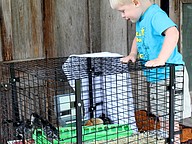- January 11, 2025
-
-
Loading

Loading
Trevin, Tucker, and Braeden Barry sit on the Whidden-Clark porch, while their grandma, Susan Barry, takes a break from weaving pine needle baskets. Photo by Jacque Estes
Tucker the farm dog decided if rides were going to be provided at Family Farm Day, he might as well hop on the wagon. Photo by Jacque Estes
Max Patterson pets Tucker, the farm dog, at Family Farm Day on Saturday, April 16. Photo by Jacque Estes
Kasie Share, 18 months, admires her new hand-made pinwheel at Family Farm Day on Saturday. Photo by Jacque Estes
James Laskis, 5, watches as Cheyenne Helt makes a pinwheel for him. Photo by Jacque Estes
Cindy and Jeff Hoblick, and their son Jack came from DeLeon Springs for the event, and to see Kara Hoblick, Jeff's sister, who is also the community liaison for the museum. They are learning about bees from Douglas Gabbert. Photo by Jacque Estes
Douglas Gabbert, bee keeper from Gabbert Honey Farm, had diagrams and bee hives to show how the honey is gathered to Lacy Smith, and her son, Isaac, 7.Photo by Jacque Estes
Wagons pulled by tractors, were the mode of transportation during Family Farm Day. Photo by Jacque Estes
Brian Rumler (circa 1835) and Rooster Morrell (circa 1870) shared stories during Family Farm Day at the Florida Agricultural Museum. Photo by Jacque Estes
Alexis Pelotte and Kylie Anderson of Palm Coast, watch Mary Randi demonstrate finger weaving at Family Farm Day on Saturday, April 16. Photo by Jacque Estes
Hands-on activities included grinding corn. Photo by Jacque Estes
Jazmine Allen, a volunteer at the Family Farm Day event, washes a shirt with a washboard. Photo by Jacque Estes

Elijah Grenet of Ormond Beach, enjoyed watching the chicks at Family Farm Day. Photo by Jacque Estes
Amanda and Mathew Birchard of Bunnell, brought their children, Zoey and Jaymin to Family Farm Day at the Florida Agricultural Museum on Saturday as a field trip for Zoey. Photo by Jacque Estes
Ci Ci and James Lee Gunn, grind corn for chicken feed. Photo by Jacque Estes
The North Florida Antique Engine Association members had a wide variety of antique engines chugging away on the field across from the Whidden-Clark Homestead. Photo by Jacque Estes
The Whidden-Clark Homestead at Famlly Farm Day. Photo by Jacque Estes
Susan Barry weaves pine needle baskets, while grandson, Braeden looks on. Photo by Jacque Estes
Max Patterson climbed aboard a wagon to take a journey. A journey from city life to farm life, as it would have been more than 100 years ago.
The 13-month-old boy wasn't as impressed by the history, as he was about riding in the wagon pulled by a tractor, and being greeted by Tucker, the resident farm hound.
Tucker, the official hound in residence at the Florida Agricultural Museum, decided to check out the wagon full of people being taken to the Whidden-Clark Homestead. After a couple of laps around the wagon, and one leap over the benches into unsuspecting laps, Tucker hopped off at the final destination.
Everyone seemed to take the canine's ad-lib interaction with humor, but Tucker was seen on the end of a leash, for the remainder of the day. Something not typical for the shelter adopted dog, accustomed to having the run of the farm, as dogs of the era would have enjoyed.
It was very easy to get into the spirit of the event, and for a moment, forget it was 2016.
Susan Barry rocked on the porch of the homestead, weaving pine needles into baskets, with her grandsons, Braeden, Trevin, and Tucker at her feet, asking questions, and looking for some treats to eat.
On the backside of the house, 12-year-old Jazmine, washed clothes on a washboard, with water pumped from a temperamental hand pump.
“It takes a long time (to wash clothes on a washboard), and you can't ever get the stains out,” Jazmine said as she spread open the man's shirt she had been trying to get clean, but still bore a black stain.
Behind her, Ci Ci and James Lee Gunn of Ormond Beach, ground corn for chicken feed. James knew exactly what he was doing, he had been at the Florida Agricultural Museum before, on a school field trip.
The visit to Family Farm Day on Saturday, April 16, was a field trip for home schooled Zoey Birchard of Bunnell.
Rooster Morrell, a cow camp cowboy, in the 1870s stood by his wagon. Those who asked about his CS (Confederate States) belt buckle, were told about the importance of the cow camps during the War of Northern Aggression, and how their job was to provide beef for the Confederate soldiers.
Admiring his wagon was Brian Rumler, an 1835 Homesteader.
“We're Homesteaders from the Carolinas,” he said. “Land was too expensive there so we came here to give it a try.”
Visitors could make butter, and take radish seeds home to grow, at Lisa Gaskall table. Gaskall works with Florida Agriculture in the Classroom.
Kara Hoblick, community liaison for the Florida Agricultural Museum, admitted she was a bit nervous when she got up Saturday morning. The weather threatened to ruin the event. She even had some vendors who decided not to come, but they missed out, because the weather was perfect, and a good time was had by all – except maybe Tucker the dog.